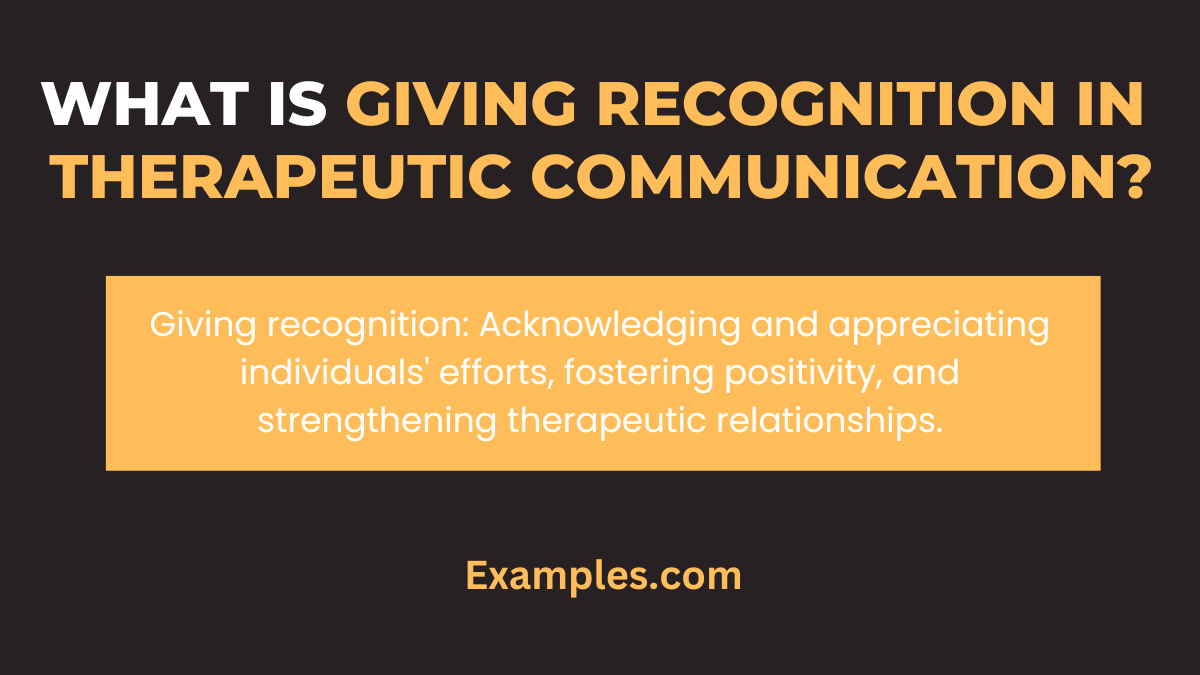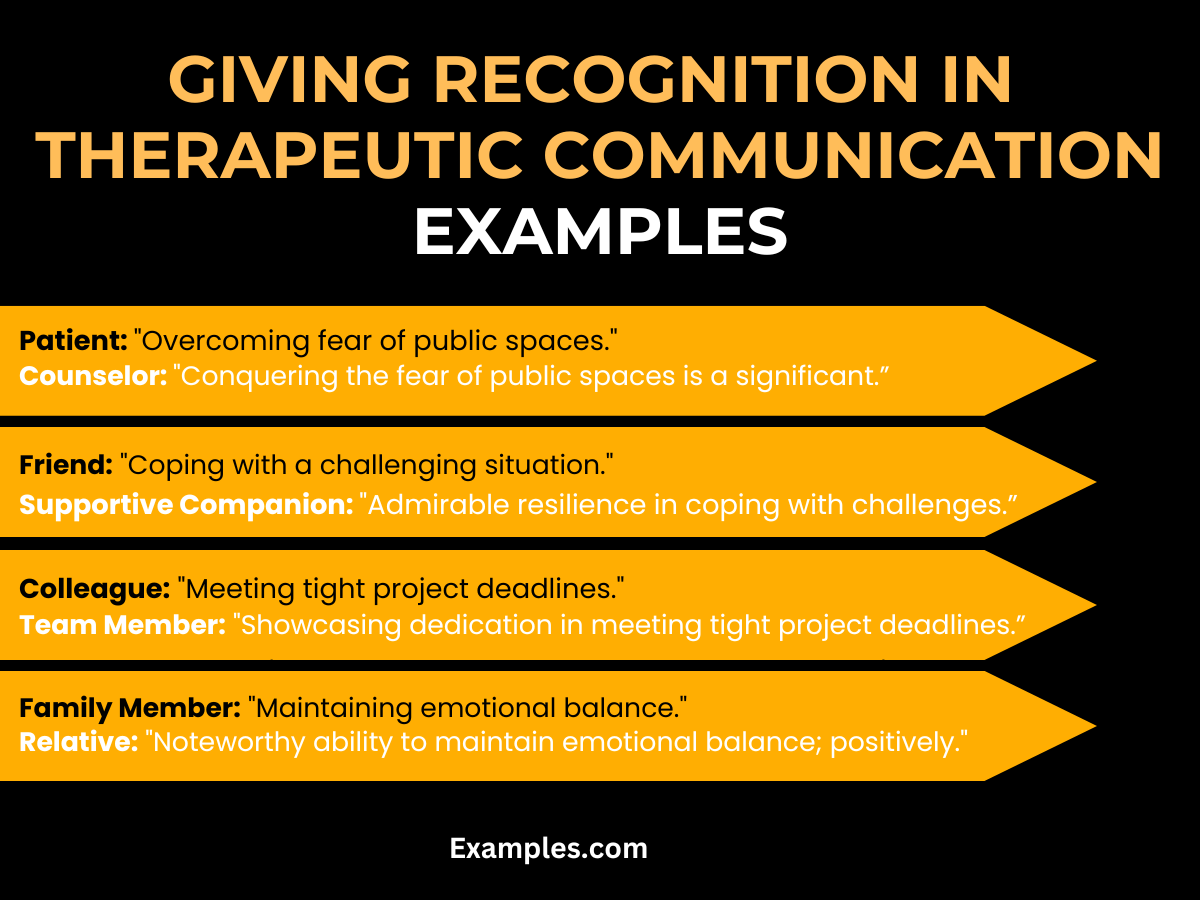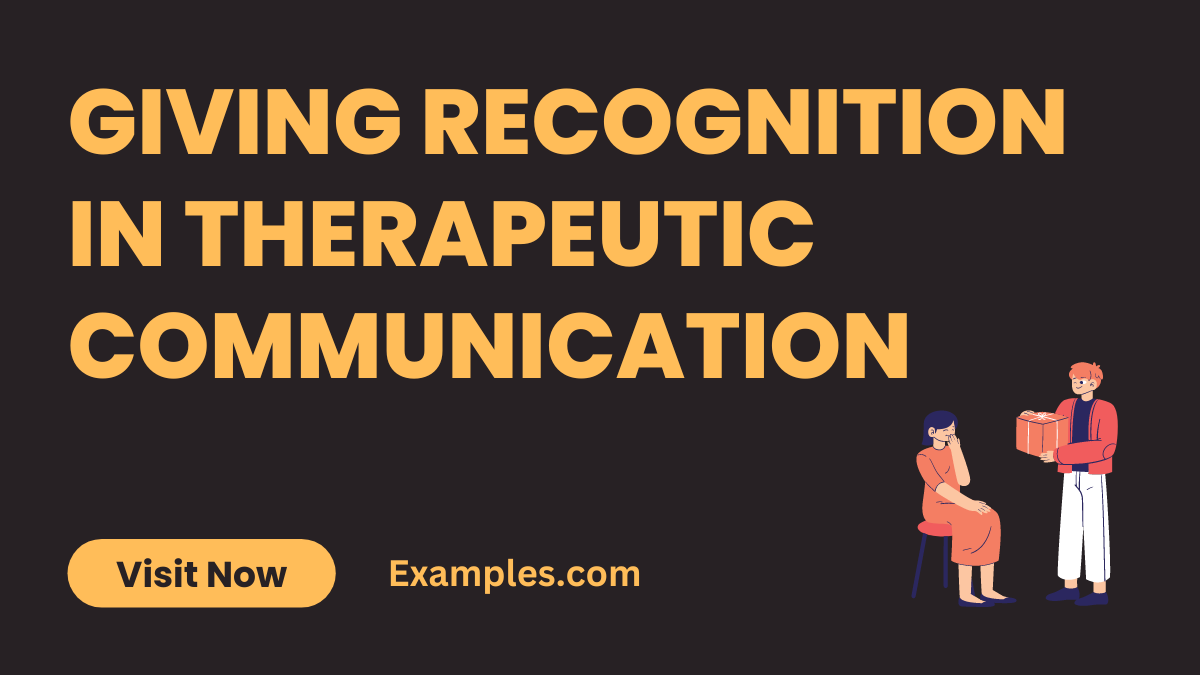Giving Recognition in Therapeutic Communication
Embark on a transformative journey with our comprehensive guide on Giving Recognition in Therapeutic Communication. Explore the art of acknowledgment and validation through real-life communication examples. This guide not only introduces recognition techniques but also provides practical tips for seamless integration. Elevate your therapeutic interactions by learning how to effectively give recognition, fostering a positive and trusting environment in various interpersonal scenarios.
What is Giving Recognition in Therapeutic Communication?

Giving Recognition in Therapeutic Communication involves acknowledging and validating the thoughts, feelings, or efforts expressed by an individual during therapeutic interactions. This deliberate act of appreciation fosters a positive and trusting environment, reinforcing the therapeutic relationship. By recognizing and affirming the speaker’s experiences, emotions, or achievements, this technique contributes to a supportive atmosphere, enhancing the effectiveness of therapeutic communication.
20 Giving Recognition in Therapeutic Communication Examples

Uncover the power of acknowledgment with our guide on Giving Recognition in Therapeutic Communication. This resource delves into the nuances of recognizing and validating expressions during therapeutic interactions. Elevate your communication skills by exploring real-life examples and expert tips, fostering a positive and empathetic therapeutic environment.
- Client: “I made progress in managing anxiety.”
- Therapist: “Your progress in managing anxiety is commendable; your efforts are truly recognized.”
- Patient: “Overcoming a fear of public spaces.”
- Mental Health Professional: “Conquering your fear of public spaces is a significant achievement; you should feel proud.”
- Friend: “Coping with a challenging situation.”
- Supportive Companion: “Your resilience in coping with challenges is admirable; you’re doing exceptionally well.”
- Colleague: “Meeting tight project deadlines.”
- Team Member: “Meeting tight project deadlines showcases your dedication and hard work; your commitment is recognized.”
- Family Member: “Maintaining emotional balance.”
- Relative: “Your ability to maintain emotional balance is noteworthy; it contributes positively to our family dynamics.”
- Student: “Improving academic performance.”
- Educator: “Your dedication to improving academic performance is evident; your hard work is acknowledged.”
- Employee: “Contributing innovative ideas at work.”
- Manager: “Your contribution of innovative ideas at work is valued; your creativity is recognized within the team.”
- Client: “Making positive lifestyle changes.”
- Counselor: “Committing to positive lifestyle changes is a significant step; your determination is acknowledged.”
- Teenager: “Building self-confidence.”
- Parent: “Your journey in building self-confidence is impressive; your growth is recognized and celebrated.”
- Patient: “Adhering to a challenging treatment plan.”
- Healthcare Provider: “Adhering to a challenging treatment plan demonstrates your commitment; your dedication is recognized.”
- Friend: “Navigating a complex relationship issue.”
- Confidante: “Your ability to navigate complex relationship issues is commendable; your maturity in handling it is recognized.”
- Co-worker: “Supporting team members during challenges.”
- Team Leader: “Your support for team members during challenges is invaluable; your teamwork is recognized.”
- Family Member: “Consistently showing empathy.”
- Sibling: “Consistently showing empathy contributes positively to our family; your understanding is recognized.”
- Student: “Demonstrating leadership in group projects.”
- Classmate: “Your leadership in group projects is noteworthy; your collaborative spirit is recognized by the class.”
- Employee: “Handling constructive criticism gracefully.”
- Supervisor: “Handling constructive criticism gracefully reflects your professionalism; your resilience is recognized.”
- Client: “Actively participating in therapy sessions.”
- Therapist: “Your active participation in therapy sessions is crucial; your commitment to the process is recognized.”
- Teenager: “Expressing emotions openly.”
- Counselor: “Your openness in expressing emotions is a positive step; your courage is recognized and respected.”
- Friend: “Demonstrating resilience after setbacks.”
- Supportive Friend: “Your resilience after setbacks is inspiring; your strength in challenging times is recognized.”
- Patient: “Adapting well to lifestyle changes.”
- Healthcare Professional: “Adapting well to lifestyle changes showcases your resilience; your efforts are recognized and appreciated.”
- Employee: “Balancing work and personal life effectively.”
- Manager: “Your ability to balance work and personal life is commendable; your dedication is recognized within the organization.”
Giving Recognition in Therapeutic Communication Examples for Nursing Students
Empower your journey in nursing education with our guide on giving recognition in therapeutic communication. Discover effective ways to appreciate and validate the efforts of nursing students, fostering a positive and supportive learning environment.
- Nursing Student: “Successfully mastered complex medical procedures.”
- Instructor: “Your mastery of complex medical procedures showcases dedication and proficiency in nursing education.”
- Nursing Student: “Consistently demonstrating empathy towards patients.”
- Clinical Mentor: “Consistently showing empathy toward patients reflects your commitment to compassionate care in nursing.”
- Nursing Student: “Achieving academic excellence in challenging coursework.”
- Faculty Member: “Your academic excellence in challenging coursework is commendable, setting a high standard for nursing education.”
- Nursing Student: “Effectively managing stressful clinical situations.”
- Preceptor: “Efficiently managing stressful clinical situations demonstrates resilience and adaptability in nursing education.”
- Nursing Student: “Leading and supporting peers in group projects.”
- Classmate: “Your leadership and support in group projects contribute significantly to a collaborative learning environment in nursing.”
Giving Recognition in Therapeutic Communication Examples at the Hospital
Navigate the hospital setting with grace using our guide on giving recognition in therapeutic communication. Explore examples tailored to hospital environments, emphasizing the importance of acknowledgment in healthcare interactions.
- Hospital Staff: “Exemplary teamwork during a critical patient situation.”
- Supervisor: “Your exemplary teamwork during a critical patient situation is commendable and contributes to optimal patient care.”
- Hospital Staff: “Consistently ensuring patient comfort and satisfaction.”
- Patient Relations Officer: “Consistently ensuring patient comfort and satisfaction reflects your commitment to the hospital’s quality of care.”
- Hospital Staff: “Efficiently implementing new protocols for enhanced efficiency.”
- Department Head: “Efficiently implementing new protocols demonstrates your dedication to improving hospital operations and patient care.”
- Hospital Staff: “Quick thinking and effective response during emergencies.”
- Emergency Department Manager: “Your quick thinking and effective response during emergencies contribute significantly to the hospital’s preparedness and patient safety.”
- Hospital Staff: “Initiating positive changes in patient communication strategies.”
- Communication Coordinator: “Your initiative in positive changes to patient communication strategies enhances the hospital’s commitment to compassionate and effective care.”
Which Nursing Statement is the Therapeutic Communication Technique of Giving Recognition?
In therapeutic communication, giving recognition involves acknowledging and validating the thoughts, feelings, or efforts expressed by a nursing individual. Here’s how to identify this technique:
- Explicit Acknowledgment: Statements explicitly recognizing a nurse’s actions, achievements, or emotions.
- Nursing Supervisor: “I appreciate your dedication to providing exceptional patient care during challenging situations.”
- Validation of Efforts: Recognition involves affirming the nurse’s efforts, showcasing appreciation for their hard work.
- Clinical Instructor: “Your diligence in mastering complex medical procedures is truly commendable.”
- Acknowledgment of Emotions: Recognizing and validating the emotional experiences of nursing professionals.
- Preceptor: “Handling stressful clinical situations with such resilience demonstrates your emotional strength in nursing.”
How Helpful is Giving recognition in Therapeutic Communication?

The practice of giving recognition in therapeutic communication is invaluable for fostering a positive and supportive environment in healthcare settings. Here’s why:
- Boosts Morale: Recognition uplifts the spirits of nursing professionals, boosting morale and job satisfaction.
- Strengthens Relationships: Acknowledging efforts strengthens the therapeutic relationship between healthcare providers and enhances teamwork.
- Enhances Motivation: Recognized nurses are more motivated, leading to increased productivity and commitment to quality care.
- Promotes Well-Being: Feeling appreciated contributes to the overall well-being of nursing staff, reducing burnout and stress.
- Improves Patient Care: A culture of recognition positively impacts patient care by promoting collaboration and dedication among healthcare providers.
Tips for Effective Giving recognition in Therapeutic Communications
To ensure effective giving recognition in therapeutic communication, consider the following tips:
- Be Specific: Provide detailed and specific feedback about the nurse’s actions or achievements.
- Timely Recognition: Offer recognition promptly to ensure its impact on motivation and morale.
- Authenticity Matters: Ensure that your acknowledgment is genuine and sincere to resonate with nursing professionals.
- Encourage Peer Recognition: Foster a culture where colleagues recognize each other, promoting a supportive team environment.
- Connect with Individual Strengths: Tailor recognition to highlight each nurse’s unique strengths, talents, and contributions.
- Use Positive Language: Frame recognition in positive language, emphasizing the positive impact of the nurse’s actions.
- Celebrate Milestones: Acknowledge major achievements and milestones in a nurse’s career to celebrate their dedication and growth.
- Include Patient Feedback: Share positive patient feedback with the nurse, reinforcing the impact of their care on patients.
In conclusion, embracing giving recognition in therapeutic communication is pivotal for cultivating a positive healthcare environment. Through genuine acknowledgment of efforts and achievements, professionals are empowered, fostering enhanced teamwork and patient care. This comprehensive guide, coupled with real-world examples, equips healthcare providers with the tools to uplift and appreciate the vital contributions of their team.



